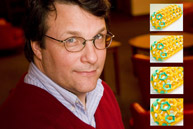Bruce Lennox: Small ideas (really small ideas)
Bruce Lennox: Small ideas (really small ideas) McGill University
User Tools (skip):
Coming up with small ideas (really small ideas)
Bruce Lennox thinks globally and acts locally. Extremely locally. So locally that his work pertains to atomic force microscopes, cell membranes and clusters of 200 or so atoms of gold — things that exist on the "nano" scale. Although he works in the Department of Chemistry (of which he is also the chair), Lennox has found applications for his infinitesimal creations that span the world of science.

Chair of the Department of Chemistry Bruce Lennox
Claudio Calligaris
"Nano" is a metric prefix meaning, in terms of length, one millionth of a millimetre. The major challenge of nanotechnology is positioning atoms, molecules and clusters in such a way that they can control or influence biological or mechanical processes that operate on a very small scale.
Arrays of gold nanoparticles are made using a flexible method called self-assembly. Lennox and colleagues make large quantities of molecules or nanoparticles with specific shapes and sizes, and simply see what the resulting material looks like. "What makes them a material is that once you introduce these molecules to one another, they self-organize," he explains, much like bricks that organize themselves to make a wall.
The challenge chemists face in this process is varying the properties of the molecules and their surrounding solutions to create manageable and useful materials. Changing the shape of the brick by repositioning bonds or functional groups, or changing the mortar that surrounds the bricks, will change the character of the resulting wall. "You can make a small change in part of the molecule and instead of the assembly becoming a sphere, it will become a rod. And if you make another small change, the rod will become a sheet. We're particularly interested in making one molecule that will change its shape when you change its environment."
The nanoparticle walls Lennox makes consist of tiny gold molecule bricks dispersed in polymer mortar. Without the polymer, gold tends to form large clusters that are not useful on such a small scale, so this aggregation must be prevented. But once you can get the gold to stay in the right places, some very interesting optical and electrical properties result. These properties have led to several successful commercial and industrial applications, ranging from iridescent vehicle paints to molecular-level machines and nanoscale electronics.
For Lennox, the best applications are those that help to advance scientific research. "Finding a community for the materials we're going to make and creating an opportunity to do a world class experiment with a new tool is what I'm really interested in," he says. The research group has worked with pharmacologists, physicists and biochemists from various universities, and is currently working with engineers at l'Université de Sherbrooke. "Either they provide materials for us to integrate with our nanomaterials, or they have a state-of-the-art use for it. We're kind of a pivot point in many ways."
Perhaps the most exciting research application is for bioimaging, the science of making pictures of living processes. Colloidal gold (clusters of gold dispersed in a solution) has been used for decades to image biological structures and events. However, the size of colloidal gold clusters (20 nanometres or more) is large compared to biological constructs like organelles, which makes labelling these tiny structures difficult. "Once you get down to the two-nanometre range of our gold clusters," says Lennox, "that's the width of a lipid membrane. We now know we can actually embed [nanoparticles] in a lipid membrane, and make a solution of lipid vesicles that have the particles in their membranes." For researchers who need to look at finely detailed cellular structures, this is a tremendous advance.
Scientific partnerships have given Lennox's research group additional challenges and guided the refinement of nanomaterials, furthering their own research. But in another sense, such partnerships have done much more: they have made use of a new scientific tool in unique ways. Lennox believes that the creation of new research tools is what really advances science, rather than the development of new theories. And sometimes, new tools can even be used outside the realm of science. In January, Lennox contributed nanoimaging technology to an artist called Ælab, who used images of spiderwebs and carbon in an aesthetic context for a piece called "DATA."
It is clear that Lennox has found a gold mine for new ideas. The breadth of interests and applications he has found for his work is a testament to the enjoyment he takes in his research, and hints at how his work has captured the imagination of countless successful graduate students and research partners. Although nanomaterials are far too small to see with the naked eye, when looking around Lennox's office, one can see what he makes: shelves are lined with molecular models of nanostructures, in plastic and origami. You can do big things with very small things, after all, and nanoscience is the business of helping people do big things.
WARM-SPARK (Writing About Research at McGill-Students Promoting Awareness of Research Knowledge) is a program sponsored by the Faculty of Science, the Offices of the Vice-Principal (Research) and University Relations, NSERC, the Faculty of Engineering and the Faculty of Agriculture & Environmental Sciences. See www.spark.mcgill.ca for more information and articles.
